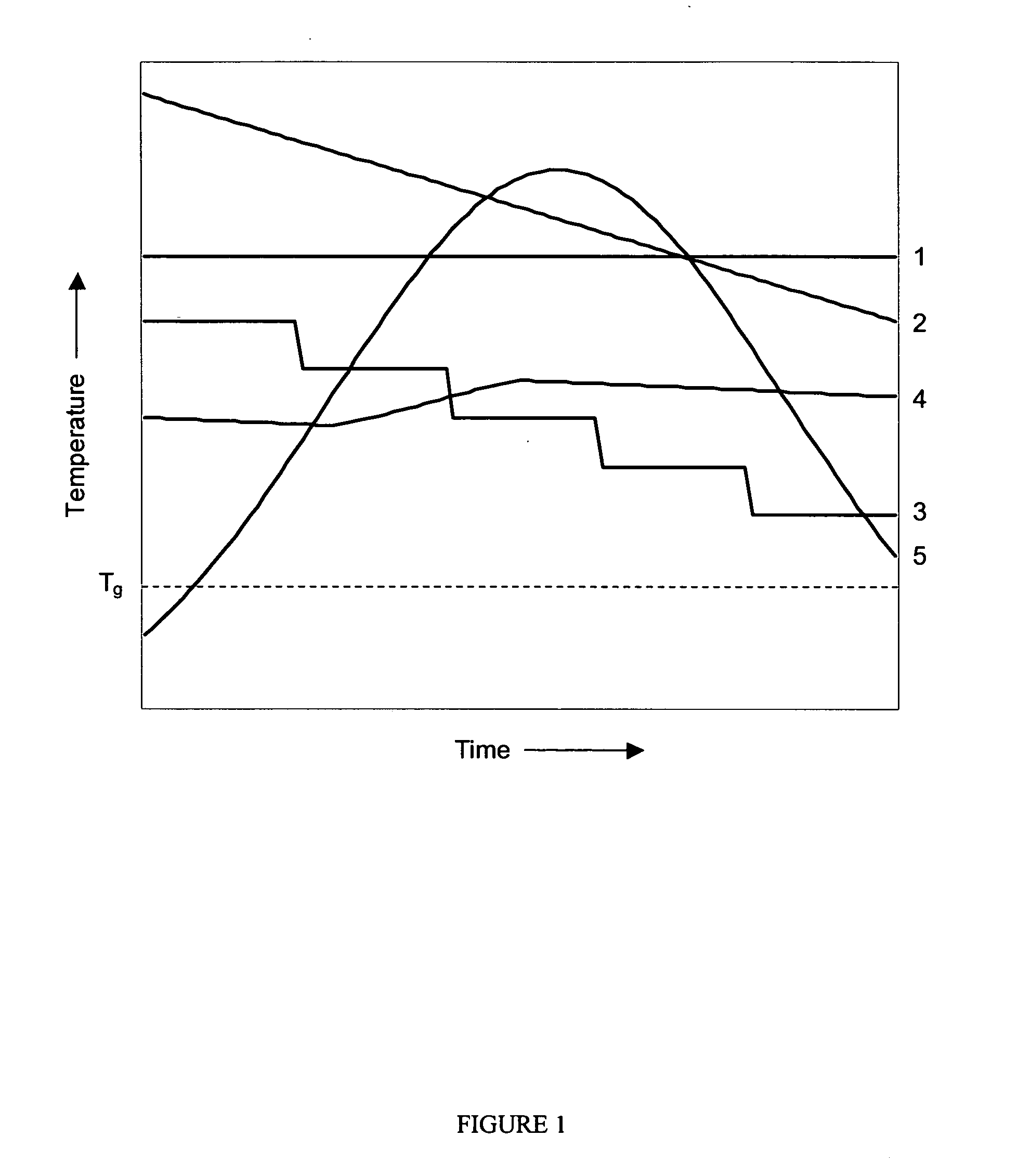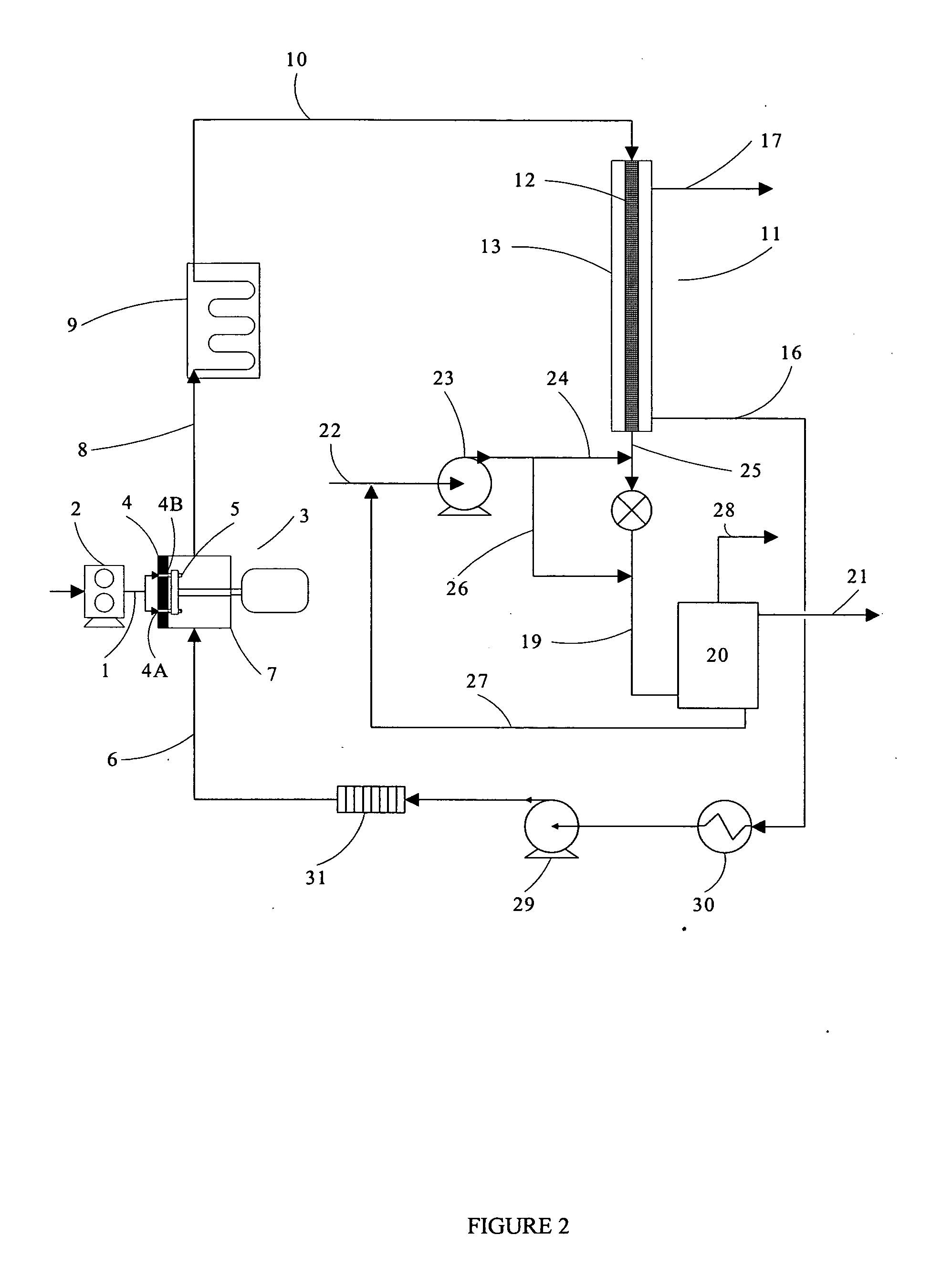Thermal crystallization of a molten polyester polymer in a fluid
- Summary
- Abstract
- Description
- Claims
- Application Information
AI Technical Summary
Benefits of technology
Problems solved by technology
Method used
Image
Examples
example 1
[0185] Triethylene glycol (TEG) was the liquid used in the following examples. For the first set of examples, three types of amorphous PET pellets were crystallized, and if needed, dried. Crystallization was done in a paddle-stirred crystallizer with an electrically heated jacket. The pellets were heated at 150° C. for 1 hour, followed by 1 h at 180° C. Since the melt was obtained by extruding pellets, it was necessary to crystallize the PET prior to the experiment in order that 1) the PET could be dried above Tg without sticking, and 2) the PET would not crystallize in the extruder and subsequently wrap the screw. Moreover, in this Example 1 and in Example 2, the use of crystallized pellets having a thermal history prior to melt extrusion simulates a process wherein recycled or scrap PET is subjected to the process of the invention. The crystallized pellets were submitted for testing and extruded in an APV Sterling with a 1.25 inch screw. Extruder zones 1-4 were set at 280° C. and ...
example 2
[0192] The same procedure as used in Example 1 was followed, except that a different polyester polymer was used as the test sample. The results are reported in Table 2.
TABLE 2MoltenPolymer BReferenceTemp_(degTimeTm1b Peak%IV#C.)(min)Temp (deg C.)Crystallinity(dL / g)103-11500245.124.980.727103-21501246.3311.580.723103-31502245.724.280.725103-41504246.3732.170.73103-51508247.229.200.721103-615015 245.529.800.724103-71502247.2522.140.727
*Polymer B as a starting pellet was a 0.79 Ih.V. PET polymer modified with 2.7 mole % isophthalic acid (IPA) and 3.7 mole % DEG.
[0193]FIG. 7 graphically illustrates the data in Table 2 with respect to the degree of crystallinity obtained from the melt over time. As can be seen from FIG. 7, a high Ih.V. polymer melt successfully crystallized very quickly in 150° CTEG. Between 2 to 5 minutes, the molten polyester polymer had achieved a degree of crystallization of about 30% or more. The data in Table 2 also shows that the high Ih.V. polymer did not suff...
example 3
[0194] The previous samples and runs in the above examples were carried out by charging crystallized PET pellets, melting the pellets in an extruder to substantially erase its thermal history and crystallinity, followed by extruding the polymer melt and crystallizing it in hot TEG. The previously-crystalline extrudate may be nucleated by some remnant of its past heat history. Example 3 now demonstrates the effect of subjecting molten polymer exiting a melt-phase line which has no prior thermal crystallization history, to the process of the invention.
[0195] To demonstrate that a polymer melt exiting a melt phase line will also crystallize from the melt at a reasonable rate, the following experiment was conducted. Molten Polymer C had a similar composition as used in Example 1, that is, a 0.575 Ih.V. PET polymer modified with 2.2 wt % 1,4-cyclohexanedimethanol (CHDM) and 1.8 wt. % DEG, except that this polymer was not previously isolated as a pellet below Tg nor crystallized from the...
PUM
| Property | Measurement | Unit |
|---|---|---|
| Temperature | aaaaa | aaaaa |
| Temperature | aaaaa | aaaaa |
| Temperature | aaaaa | aaaaa |
Abstract
Description
Claims
Application Information
 Login to View More
Login to View More - R&D
- Intellectual Property
- Life Sciences
- Materials
- Tech Scout
- Unparalleled Data Quality
- Higher Quality Content
- 60% Fewer Hallucinations
Browse by: Latest US Patents, China's latest patents, Technical Efficacy Thesaurus, Application Domain, Technology Topic, Popular Technical Reports.
© 2025 PatSnap. All rights reserved.Legal|Privacy policy|Modern Slavery Act Transparency Statement|Sitemap|About US| Contact US: help@patsnap.com



